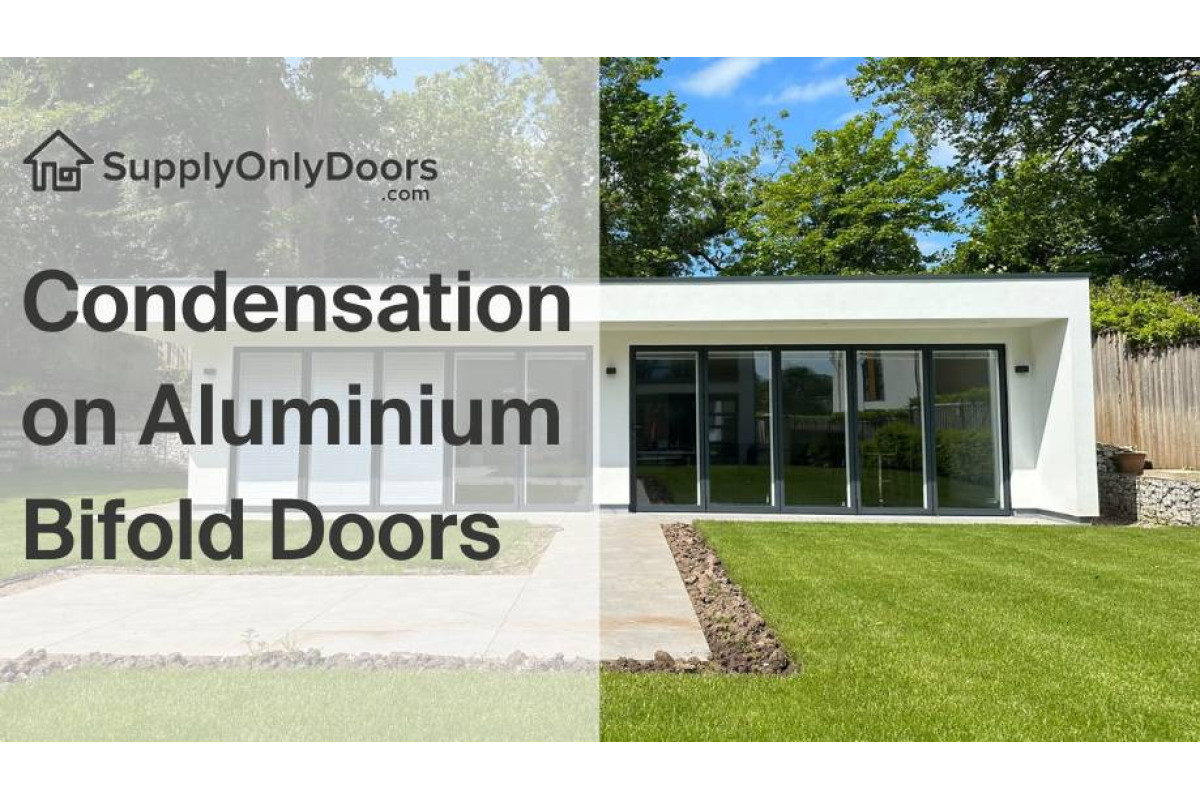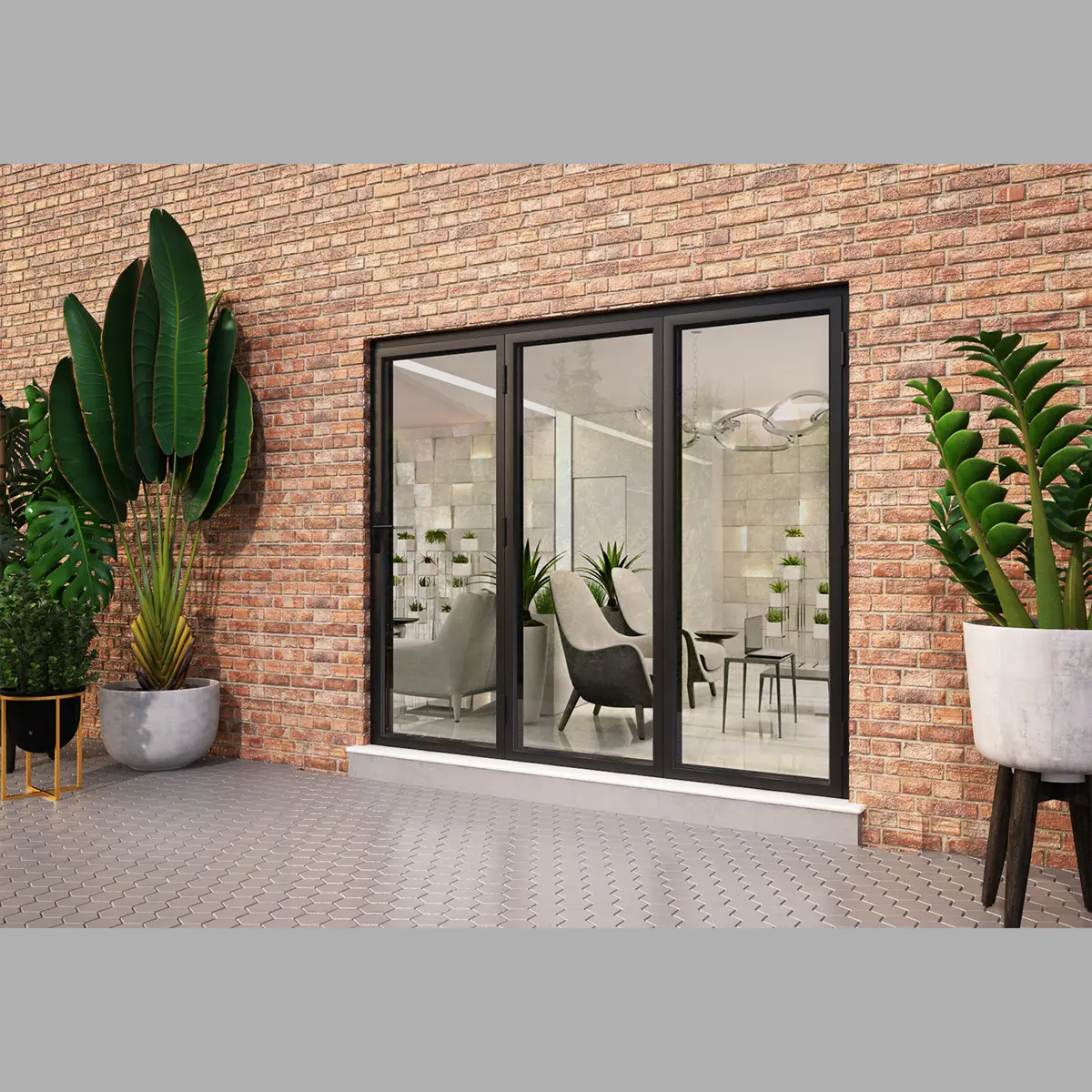Condensation On Aluminium Bifold Doors

In the months preceding Winter, the outside temperatures fluctuate, meaning we experience warmer days and nights that get increasingly colder as Winter approaches. The result is increasing condensation outside our homes, especially those with double glazing.
What Causes the Condensation and What to Do?
If you notice condensation on your double-glazed doors, you might assume your doors are at fault, but they’re not. The condensation evident during September and October is normal and isn’t connected to your doors, windows, or glass. Let’s look at further information about what causes condensation on aluminium doors and offer some advice on what you can do about it.
The first cause of the condensation
The condensation is likely not caused by any house defect like rising dampness or mould. Still, it results from an increase in interior moisture, and it’s pretty standard on aluminium bifold doors and windows during Autumn and Winter.
Condensation occurs when warm air with a high moisture content contacts cold surfaces. When the air touches a cold surface, like a door or window, it releases this excess moisture, which forms condensation droplets as it converts to liquid.
For obvious reasons, we keep our doors, windows and roof lanterns closed during the colder months, so there is less air circulation and ventilation inside, with warmer air containing more moisture. Conversely, outside is growing colder due to the seasons, meaning a lower temperature and a more significant thermal differential between inside and out.
With these kinds of temperature differences in play, condensation thrives because:-
- The inside air is already warm due to central heating.
- We’re creating moisture in the air by washing, cooking, bathing, sleeping, and breathing.
- The outside of our aluminium doors and windows are directly exposed to the colder outside weather conditions.
So, when the combination combines, you end up with warm and moist interior air, cold aluminium frames and glass, and immediate condensation issues.
The second cause of the condensation
Aluminium has a decent record in terms of its insulating properties, which means it’s an excellent choice for items like door and window frames in UK homes. The energy efficiency of modern aluminium bifold doors and windows incorporates the entire door and window design, not only the double-glazed glass.
The latest aluminium designs afford greater insulation, so you can lower your carbon footprint and maintain the warmth of your home simultaneously through less energy consumption.
It may interest you that aluminium frames are no colder to the touch than materials like uPVC, which is also not generally as environmentally friendly as aluminium. There are many other areas where aluminium vs uPVC bifold doors reveal some interesting facts.
The long and the short of it is that aluminium can contribute to condensation issues, but only due to its insulating properties and not because it gets noticeably colder than other popular door and window materials.
Some window and door companies will tell you that their products eliminate condensation. Still, while double-glazed units will assist in reducing it, several other factors produce excess moisture in the air, which is the root cause of condensation. No new door or window will prevent condensation entirely, so read more about aluminium doors and consider the benefits.
Ways to Reduce Condensation on Aluminium Bifold Doors
There are many effective ways to release moisture from the humid air and reduce condensation on your home’s aluminium bifold doors and windows, no matter how cold the outside temperature is.
Find the source and restrict excess moisture
There’s no doubt where most excess moisture is generated in a home. The kitchen and bathroom are the two rooms in any house that release the most moisture, contributing to condensation issues. Think about it – hot showers and baths, boiling pots on the stove, roasting food in the oven, and everybody’s steaming plates on the counter.
All of the above release moisture into the air, creating excess humidity, which filters into the rest of the home and settles on the coldest surfaces – your windows and doors exposed to the outside elements – to encourage condensation.
If you’re generating heat in your bathroom or kitchen, make sure you close the door and switch on your extractor fan if you’ve got one. If you don’t have one, perhaps you should consider an installation in the bathroom and kitchen, as its purpose is to extract warm and humid air from your living environment.
Alternatively, switch on a regular fan for at least 15 minutes when you’re finished in the room and close the door behind you.
Install a hygrometer
Without a monitoring device, it’s not simple to see or feel moisture build up in your living environment. A hygrometer almost looks like a clock and is ideal for keeping an eye on your home’s RH, or relative humidity, level.
A UK household typically has an RH level of between 45% and 55%, so if you notice the level climbing above this, switch on your fan, extraction fan or dehumidifier, or even open some doors or windows for a while.
Make use of a dehumidifier
We all know that a dehumidifier is excellent for getting rid of mould, but it doesn’t directly kill the mould; it lowers the relative humidity in a home which, in turn, stops the mould from growing. For this reason, a dehumidifier is potentially one of the best tools for combatting condensation.
So dehumidifiers lower your home’s humidity levels. Also, many newer models can monitor the RH levels in your house and automatically switch them off and on for increased energy efficiency. Dehumidifiers also warm the places where they’re operating, with the dryer air emitted being 3-5 degrees warmer than the ambient air it’s replacing.
Many dehumidifiers also contain shutters that allow you to aim the dryer air in the direction of a window or door to remove any built-up condensation or heat the area. Hence, it’s less likely to appear there in the first place. Taking moisture from the air makes the creation of condensation much less likely, and a dehumidifier is probably the best way of doing this.
Plan your indoor clothes drying
Although tumble dryers are effective for drying your clothes indoors, they aren’t energy efficient, and it’s no wonder many are white elephants in homes due to inflating energy prices. This is a good thing if you’re battling condensation on your aluminium bifold doors and windows, as a tumble dryer likely creates condensation more than most other home appliances.
Drying your washing inside your house will release plenty of moisture into the air, and nothing will change that. The trick is to limit the effect of this moisture by planning how you dry your clothes. We recommend you put the following simple measures in place to do this.
- Use one room to dry your washing.
- Please close the door and keep it closed so the moisture spread is limited.
- Leave the window in the drying room open, even if it’s only one window latch notch, to allow the humid air to escape. If you need to, block the gap underneath the door to keep the cold air from escaping into the rest of your house.
Use a window vac for existing condensation
A window vac won’t prevent the build-up of condensation but can assist in removing it from glass surfaces. Window vacs were created to remove excess dirt and soap water from widow panes, but they’re also an effective way to eliminate existing condensation.
It’s easy to remove a large amount of condensation in only a few minutes, and you won’t need to wet and dirty your towels to remove them, which means no more wet towels to release further moisture inside your home. It’s also less messy as you spill the excess water collected straight down the sink or in the bushes outside.
Although you’ll never find a door that keeps condensation at bay completely, the above tips might help you put some steps in place to eliminate the problem completely. Aluminium bifold doors are certainly not immune from the risk of condensation, but the aluminium door options we have to offer will undoubtedly keep you warm inside and reduce your energy bill.
FAQs
What are trickle vents on aluminium bifold doors?
A trickle vent is a device on a bifold door that provides a consistent flow of clean air into a room. It doesn’t cause a draught and will assist in reducing condensation.
Trickle vents can also be found on sliding patio doors and French doors, as they are required for ventilation purposes.
When you open a trickle vent, will it stop condensation?
A trickle vent allows ventilation in and will reduce the chance of condensation by allowing humid air to escape. A trickle vent will not guarantee you won’t get any condensation.
Should I wipe condensation from my aluminium bifold doors?
Remove any condensation first thing in the morning when most evident. Consider getting a window vac for this purpose, and use a fresh towel or a squeegee to dry the pane properly once done.
What can cause condensation inside bifold doors?
Condensation and misting inside the bifold door window panels, it’s probable that the glazing unit seal has stopped working, allowing regular air inside the unit.
This is just one of the few problems with aluminium bifold doors that can occur but are easily solved.
Related Products

2100 x 2000 3 Panel Black On White Bifold Doors
View Product